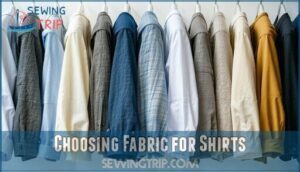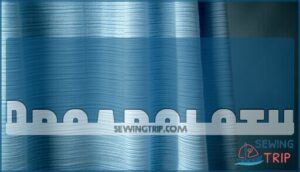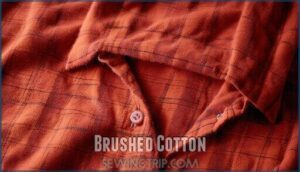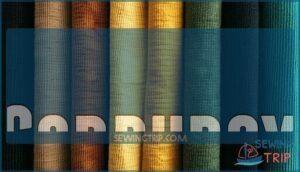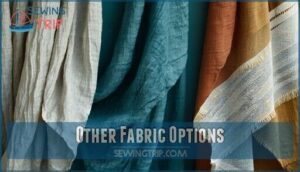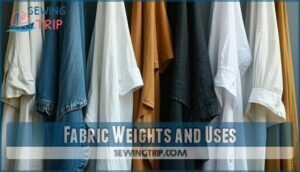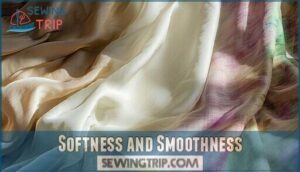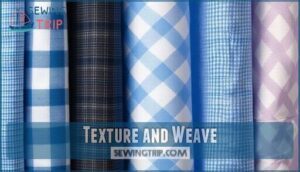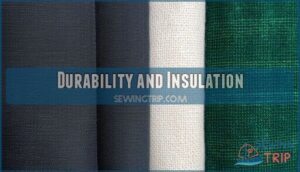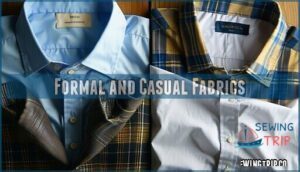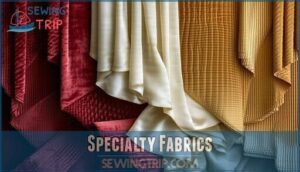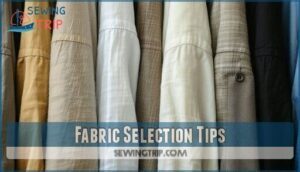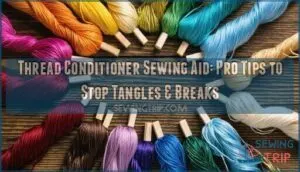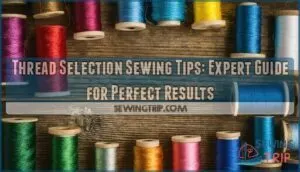This site is supported by our readers. We may earn a commission, at no cost to you, if you purchase through links.
 When choosing types of fabric for shirts, you’ll find cotton reigns supreme for comfort and breathability.
When choosing types of fabric for shirts, you’ll find cotton reigns supreme for comfort and breathability.
Cotton varieties include crisp poplin, sturdy oxford cloth, and smooth broadcloth.
Linen offers unbeatable summer coolness but wrinkles easily.
Polyester resists wrinkles and holds its shape well, though it can trap heat.
Blended fabrics combine the best of both worlds—cotton-poly blends give you comfort with easy care.
For dress shirts, you can’t beat fine cotton weaves like pinpoint or herringbone.
Casual shirts work great in chambray or brushed cotton.
Each fabric tells its own story through texture, weight, and drape, affecting how your shirt performs throughout the day, with its own unique drape.
Table Of Contents
Key Takeaways
- You’ll get the best all-around performance from cotton fabrics – they’re breathable, comfortable, and versatile enough for both casual and formal occasions, with varieties like poplin for crisp dress shirts and oxford cloth for everyday wear.
- Consider fabric weight based on your needs – lightweight fabrics under 136 GSM work best for summer and layering, while medium-weight fabrics (150-350 GSM) offer year-round versatility for most shirt applications.
- Blended fabrics give you the best of both worlds – cotton-polyester blends combine cotton’s comfort and breathability with polyester’s wrinkle resistance and durability, making them ideal for busy lifestyles.
- Match your fabric choice to your lifestyle and climate – choose breathable linen for hot weather, moisture-wicking synthetics for active wear, and heavier materials like flannel for cooler temperatures and professional settings.
Fabric Types Overview
When you’re choosing a shirt fabric, you’ll encounter four main categories: cotton fabrics, synthetic fabrics, natural fibers, and blended fabrics.
Each type offers different benefits for comfort, durability, and style, so understanding these options helps you pick the right material for your needs.
Cotton Fabrics
Cotton’s reputation as the go-to shirt fabric isn’t just hype.
Cotton earned its crown as the ultimate shirt fabric through centuries of proven comfort and reliability.
You’ll find cotton comfort unmatched, with natural breathability that keeps you cool. Cotton durability means your shirts last through countless washes, while various cotton weaves offer different textures and styles.
Key cotton advantages include:
- Pima cotton delivers premium softness and strength
- Oxford fabric provides casual versatility with basket-weave texture
- Cotton poplin offers crisp, professional appearance for formal wear
Synthetic Fabrics
Looking beyond cotton’s natural appeal, synthetic materials offer compelling advantages for modern shirts.
Polyester benefits include superior durability and moisture-wicking properties that keep you dry during active days.
Rayon properties provide silk-like smoothness at affordable prices.
Modal applications shine in creating ultra-soft fabrics.
These synthetic blends represent true fabric innovation, combining performance with comfort.
Natural Fibers
Natural fibers bring unmatched breathability and comfort to your shirts.
Cotton leads the pack with exceptional moisture absorption and skin-friendly properties.
Linen benefits include superior cooling for hot weather, while silk production creates luxurious drape and natural temperature regulation.
Wool properties offer insulation and odor resistance. Fiber sourcing matters – organic cotton reduces chemical exposure while maintaining fabric durability and softness.
Blended Fabrics
Fabric blends merge different fibers to create superior blend performance while balancing blend cost with premium benefits.
Popular polycotton combinations offer enhanced blend durability compared to pure materials, while linencotton provides improved blend comfort for everyday wear.
Modern triblend formulations combine three fibers, creating blend shirt fabric that serves multiple blend purposes.
These innovative fabric blends deliver the best characteristics from each component fiber type.
Choosing Fabric for Shirts
You’ll need to take into account several key factors when selecting fabric for your shirts, including breathability, durability, and the occasions you’ll wear them.
Your fabric choice directly affects how comfortable you feel, how long your shirt lasts, and whether it matches your personal style and seasonal needs, which can be influenced by durability.
Breathability and Comfort
When choosing shirt fabric, breathability becomes your best friend for all-day comfort.
Cotton and linen excel at moisture absorption, allowing air to flow freely through their natural fibers.
The weave impact determines how well fabric lets your skin breathe – loose weaves offer better ventilation than tight ones.
Consider skin sensitivity when selecting materials, as fabric breathability directly affects comfort factors and moisture wicking performance.
Durability and Maintenance
Smart shoppers know that durability and clothing care go hand in hand.
Cotton and linen fabrics offer excellent textile durability with proper fabric care, while synthetic blends resist stains and reduce shrinkage control issues.
You’ll find that wash frequency matters less with quality materials that prevent pilling.
Simple repair methods can extend your shirt’s lifespan substantially.
Style and Fashion
Your personal preference shapes every fabric choice you make for dress shirts.
Fashion trends shift between crisp poplin for formal occasions and relaxed chambray for casual settings.
Modern blends offer versatility across seasonal styles, letting you adapt effortlessly from boardroom to weekend hangouts.
Different fabric types serve specific purposes in occasion dressing, making your wardrobe both functional and stylish.
Seasonal Considerations
When temperatures soar, summer fabrics like linen and lightweight cotton deliver superior breathability for hot weather comfort.
Winter shirts demand heavier materials such as flannel and brushed cotton that provide insulation during cool weather months.
Weather performance matters—choose fabrics that match your climate, considering seasonal trends that shift between airy summer shirts and cozy winter options for ultimate comfort.
Cotton Fabric Varieties
You’ll find cotton offers dozens of fabric varieties, each with unique textures and weave patterns that affect your shirt’s feel and appearance.
Cotton varieties range from crisp broadcloth and casual chambray to cozy brushed cotton and textured corduroy, giving you options for every style preference and occasion.
Broadcloth
Broadcloth’s medium-weight cotton delivers exceptional versatility for dress shirts.
You’ll appreciate its plain broadcloth weave that creates subtle horizontal ribs and a soft sheen.
This broadcloth shirt fabric offers excellent broadcloth durability while maintaining breathability.
For a variety of styles, consider cotton broadcloth options.
The broadcloth cost remains reasonable, making it perfect for both formal and business broadcloth applications.
Cotton broadcloth balances sophistication with everyday comfort beautifully.
Brushed Cotton
Brushed cotton creates the perfect flannel alternative when you want that cozy winter shirting feel without the bulk.
Mechanical brushing lifts cotton fibers, boosting the softness factor substantially while maintaining breathability.
This fabric offers excellent brushed cotton warmth for cooler months.
The process of brushing creates a fuzzy, soft nap on the fabric’s surface.
Care instructions remain simple—wash in cool water and tumble dry low to preserve the plush texture that makes these shirts irresistibly comfortable.
Chambray
You’ll love chambray’s unique multi-colored appearance created by weaving different colored yarns together.
This cotton shirt fabric resembles denim but offers lighter weight and softer feel.
Chambray durability makes it perfect for casual wear, while chambray weaves create subtle texture variations.
Chambray colors range from classic blue to modern gray tones.
Chambray styling works for both relaxed and semi-formal occasions.
Consider a lightweight shirt option for warmer weather.
Corduroy
You’ll find corduroy brings a distinctive twist to shirt fabric options.
This textured material features raised vertical cords called wales that create its signature ridged appearance.
Cotton-based corduroy offers excellent durability while maintaining breathability for comfortable wear.
Corduroy’s popularity grew after being adopted by the elite, becoming a fashionable fabric choice.
- Corduroy Rib Count: Standard corduroy has 11 wales per inch, with pinwale offering finer textures
- Corduroy Durability: Robust construction withstands frequent washing and daily wear
- Corduroy Textures: Wide-wale creates bold patterns, while pinwale provides subtle sophistication
- Corduroy Colors: Available in rich earth tones and vibrant seasonal shades
- Corduroy Care: Machine washable with gentle cycle to preserve fabric structure
Other Fabric Options
You’ll find several excellent fabric alternatives beyond cotton that offer unique benefits for different shirt styles and occasions.
Linen provides exceptional breathability for hot weather, while polyester delivers durability and wrinkle resistance, and modal offers silk-like softness with easy care.
Linen
Linen stands as summer’s champion fabric, offering unmatched breathability that keeps you cool when temperatures soar.
This natural fiber excels in hot weather thanks to its loose weave structure. While linen cost runs higher than cotton, linen durability justifies the investment.
Various linen weaves create different textures, and linen blends combine comfort with reduced wrinkling for practical everyday wear.
Understanding fabric weight importance helps determine how well the material will drape.
Polyester
Polyester stands out among synthetic materials for its exceptional durability and wrinkle resistance.
You’ll find polyester shirt fabric holds its shape wash after wash, making it perfect for busy lifestyles.
Polyester blends offer enhanced polyester performance while maintaining breathability.
Polyester printing produces vibrant, long-lasting colors, and recycled polyester provides eco-friendly options without sacrificing quality or comfort.
Rayon
Rayon brings together the best of both worlds—natural comfort meets synthetic durability.
This semi-synthetic fabric offers silk-like smoothness and excellent drape for your shirts.
Rayon blends well with cotton and polyester, creating versatile tshirt materials.
While rayon production involves chemical processing, modern techniques improve rayon sustainability.
You’ll appreciate rayon’s breathability and moisture-wicking rayon properties in shirt fabrics.
Modal
Modal stands out among shirt fabrics as a semi-synthetic powerhouse derived from beech trees.
This eco-friendly material beats cotton in moisture absorption by 50% while staying incredibly soft.
Modal blends offer superior breathability and color retention for your shirts.
Its sustainability credentials and wrinkle resistance make modal applications perfect for both casual t-shirt materials and dress shirts.
Fabric Weights and Uses
You’ll find that fabric weight directly affects how your shirt looks, feels, and performs in different situations.
Understanding fabric weights measured in GSM or ounces helps you choose the right material for your specific needs, whether you’re selecting a lightweight summer shirt or a heavier winter option.
Lightweight Fabrics
When choosing shirts for warmer months, lightweight fabrics become your best friend for superior fabric breathability and summer comfort.
These materials typically weigh under 136 gsm, offering exceptional drape characteristics perfect for layering options.
Here are three top lightweight fabric choices:
- Linen fabric – naturally cooling and breathable
- Cotton shirt fabric – soft lawn varieties for transparency
- Voile shirt fabric – delicate sheer fabrics with elegant flow
Medium-Weight Fabrics
Hitting the sweet spot between casual and formal, mediumweight fabrics offer versatility you’ll appreciate.
Cotton poplin and cotton twill deliver excellent durability factors with their tighter weave density, while oxford fabric provides structure without stiffness.
These fabrics typically range 150-350 GSM ranges, making them perfect for year-round seasonal use. Blending options enhance performance while maintaining comfort.
Heavyweight Fabrics
Heavyweight fabrics weighing over 9 ounces per square yard deliver exceptional durability factors and insulation properties for winter apparel.
Dense weave structures in denim, flannel, and corduroy create rugged shirts that withstand heavy use. Twill weaves enhance strength while maintaining comfort.
These substantial materials provide warmth and longevity, making them perfect for outdoor work and cold-weather activities.
When sewing these materials, remember to keep in mind essential tools for thick fabrics to guarantee a smooth process.
Fabric Weight Measurement
Understanding fabric weight matters when you’re shopping for shirts.
GSM Explained: manufacturers measure fabric density in grams per square meter or ounces per square yard.
Oz Conversion helps you compare different materials online.
Weight Impact affects how your shirt drapes and feels.
Fabric Application determines comfort levels – lighter GSM works for summer, heavier ozyd2 for winter wear, considering the Weight Impact and Fabric Application.
Fabric Characteristics
You’ll notice that fabric characteristics determine how your shirt looks, feels, and performs throughout the day.
Understanding these key traits helps you choose materials that match your comfort needs and style preferences.
Softness and Smoothness
Your shirt’s softness depends on several key factors that transform raw materials into luxurious comfort.
Thread count plays a major role, but it’s not the whole story.
Consider these elements that determine fabric softness:
- Fiber Quality – Premium cotton, linen, and silk create naturally soft foundations
- Weave Type – Tight weaves produce smoother surfaces than loose constructions
- Fabric Blends – Strategic mixing enhances both fabric softness and fabric smoothness
- Finishing Processes – Chemical treatments and brushing techniques refine texture
Texture and Weave
Beyond how your shirt feels against your skin, the texture and weave create the fabric’s personality.
Different weave types produce distinct tactile qualities that affect both appearance and performance.
| Weave Type | Texture | Durability | Best For |
|---|---|---|---|
| Oxford Fabric | Basket weave texture | High | Casual shirts |
| Twill Weave | Diagonal ribs | Very High | Dress shirts |
| Dobby | Raised patterns | Medium | Formal wear |
| Plain Weave | Smooth surface | Medium | Everyday shirts |
Each knit structure offers unique surface interest and fabric hand characteristics, which are influenced by the weave types and their impact on the shirt’s performance.
Transparency and Drape
Some fabric types reveal more than others, affecting your shirt’s professional appearance.
Fabric opacity ranges from see-through lawn cotton to completely opaque broadcloth and poplin.
Drape styles depend on weight influence and weave impact – lighter fabrics flow softly while heavier ones maintain structure.
Seasonal drape considerations matter too, as summer shirts need breathable, flowing materials versus winter’s structured options, which can be made from completely opaque fabrics like poplin.
Durability and Insulation
Different fabrics deliver varying fabric lifespan and thermal properties you’ll want to keep in mind.
Cotton offers excellent fiber resilience with moderate insulation, while linen provides breathability but less durability.
Polyester excels in weave strength and maintains shape longer than natural fibers.
Flannel’s brushed surface creates superior thermal insulation through trapped air.
Weight impact directly affects both durability and warmth retention.
Formal and Casual Fabrics
You’ll need different shirt fabrics depending on where you’re going and what you’re doing.
Formal events call for crisp materials like broadcloth and poplin, while casual settings work well with relaxed fabrics like oxford cloth and flannel.
Formal Shirt Fabrics
When you’re dressing for business meetings or formal events, you’ll want fabrics that command respect.
Dress shirts in poplin offer crisp, professional lines with excellent thread count.
Oxford cloth provides durability with sophisticated texture, while pinpoint delivers subtle elegance.
Herringbone weave types add visual interest without being flashy.
These fabrics maintain proper shirt construction and follow standard care instructions, ensuring a professional look.
Casual Shirt Fabrics
For casual, everyday wear, you’ll want fabrics that feel as good as they look.
Chambray shirt fabric offers denim’s appeal without the weight, while flannel shirt fabric brings cozy warmth.
Jersey knit fabric provides stretch and comfort, and linen shirt material keeps you cool.
These fabric blends guarantee excellent color retention and shrinkage control for lasting quality.
Workwear Fabrics
When you’re gearing up for tough jobs, workwear fabric types matter more than you’d think.
Cotton blends dominate industrial use, offering superior fabric durability while meeting safety standards. These shirts balance comfort factors with cost analysis considerations.
Heavy-duty weaves like twill and drill withstand demanding environments.
For formal events, consider luxurious velvet options for a bold statement. Your workwear investment pays off through extended wear cycles and reliable performance across various job sites, ensuring reliable performance.
Summer and Winter Fabrics
Your fabric choice changes dramatically with the seasons.
Summer demands breathability factors like cotton and linen’s moisture absorption capabilities, while winter requires insulation properties from flannel’s cozy weave.
Seasonal fabric considerations:
- Seersucker – lightweight summer weave with natural cooling texture
- Weight differences – heavier fabrics trap warmth effectively
- Seasonal weaves – open weaves cool, tight weaves insulate
- Layering options – thinner base fabrics work better
- Breathability – prioritize airflow for comfort
Specialty Fabrics
You’ll find specialty fabrics offer unique textures and performance features that set them apart from basic cotton options.
These advanced materials include twill’s diagonal weave pattern, gabardine’s tight construction, oxford’s basket-like texture, and poplin’s smooth finish with subtle horizontal ribs.
Twill Fabrics
Diagonal ridges make twill fabric instantly recognizable and remarkably durable for everyday wear.
This distinctive weave pattern creates stronger, more resilient shirts that resist wrinkles better than plain cotton.
You’ll find twill weaves in everything from casual button-downs to work shirts, offering excellent longevity.
You can find a variety of durable twill options for demanding jobs.
| Twill Properties | Benefits |
|---|---|
| Diagonal weave pattern | Creates distinctive texture |
| Enhanced durability | Resists wear and tear |
| Wrinkle resistance | Maintains crisp appearance |
| Versatile applications | Works for casual and work shirts |
| Strong fabric structure | Provides long-lasting performance |
Gabardine Fabrics
This distinguished fabric boasts exceptional gabardine durability through its tight diagonal gabardine weave pattern.
You’ll find gabardine applications spanning professional shirts to outerwear, making it versatile for various clothing durability needs.
While gabardine cost runs higher than basic cotton types, proper gabardine care guarantees longevity.
The fabric’s water-resistant properties and wrinkle resistance make shirts ideal for business settings requiring polished appearances.
Oxford and Pinpoint Fabrics
Oxford fabric brings impressive Oxford durability through its distinctive basket weave pattern, making it perfect for both casual and semi-formal occasions.
Pinpoint fabric offers superior pinpoint texture with tighter weaving than standard oxford, creating sophisticated shirts ideal for business settings.
Here’s your weave comparison guide:
- Oxford: Coarser texture, excellent breathability, requires minimal fabric care
- Pinpoint: Smoother finish, professional appearance, wrinkle-resistant properties
- Formal usage: Pinpoint excels in corporate environments, oxford dominates weekend wear
Poplin and Sateen Fabrics
Two distinct finishes offer different looks for your wardrobe.
Poplin weave creates crisp horizontal ribs with subtle sheen, making poplin shirt fabric perfect for professional settings.
Cotton poplin resists wrinkles well.
Sateen provides smooth surfaces with dull sheen through specialized weaving.
Satin shirt fabric drapes beautifully but requires careful fabric care.
Cost analysis shows poplin typically costs less than sateen finishes.
Fabric Selection Tips
You’ll need to evaluate several key factors when choosing shirt fabrics to guarantee you get the best performance and comfort for your specific needs.
These practical guidelines will help you evaluate fabric quality, weight, and performance characteristics to make informed decisions that match your lifestyle and preferences.
Considering Lifestyle and Trends
When choosing fabric for shirts, your lifestyle shapes every decision you make.
Modern fashion trends emphasize sustainable fabrics and comfort focus, reflecting athleisure influence on everyday wear.
Trend forecasting shows seasonal styles shifting toward breathable materials and eco-friendly options.
Consider how often you’ll wear specific shirt types, matching fabric choices to your daily activities and current fabric trends, focusing on comfort focus.
Evaluating Fabric Quality
Quality fabric feels like an investment that pays dividends every time you wear it.
Smart shoppers know what separates premium materials from budget options, and it’s easier than you think.
Here’s your fabric quality checklist:
- Thread Count and Weave Quality – Higher thread counts create smoother, more durable fabrics that resist pilling and maintain their shape through countless washes.
- Fiber Purity and Dye Fastness – Pure fibers without fillers offer better breathability, while colorfast dyes prevent that embarrassing pink-shirt-in-the-laundry disaster.
- Shrink Resistance and Fabric Certifications – Look for pre-shrunk labels and quality certifications that guarantee consistent sizing and textile durability over time.
Understanding fabric characteristics helps you spot the difference between a shirt that’ll last years versus one that’ll disappoint after a few months.
Quality fabric selection tips focus on these measurable standards rather than flashy marketing claims.
Choosing The Right Fabric Weight
Fabric weight determines your shirt’s performance and comfort.
GSM Explained: lighter weights (136-237 GSM) work best for everyday wear, while heavier options (305+ GSM) provide durability for workwear.
Seasonal Weights matter—choose lightweight fabrics for summer breathability and medium weights for layering options.
Consider fabric characteristics like drape and structure when making your fabric selection decision.
Blending Fabrics for Optimal Performance
Blending cotton with polyester creates performance shirt fabric that maximizes both natural advantages and synthetic benefits.
Cotton meets synthetic innovation—unlocking the perfect balance of comfort, durability, and performance in every thread.
These comfort blends offer superior moisture-wicking** properties while maintaining breathability.
You’ll get blend durability from polyester’s strength plus cotton’s softness.
Performance weaves in fabric blends deliver the best of both worlds—cotton’s comfort meets polyester’s wrinkle resistance and quick-drying capabilities.
Frequently Asked Questions (FAQs)
What is the best fabric for a shirt?
Cotton remains your best bet for shirts.
It’s breathable, comfortable, and versatile enough for any occasion.
You’ll find it absorbs moisture well while letting your skin breathe naturally throughout the day.
What are the different types of t-shirt fabrics?
T-shirt fabrics range from breathable cotton and moisture-wicking polyester to luxurious blends.
You’ll find jersey knits, modal for softness, rayon for drape, and unique options like burnout or slub textures for distinctive looks.
What are the 3 main types of fabric?
You’ll encounter three main fabric categories when shopping.
These are: natural fibers like cotton and linen, synthetic materials such as polyester and nylon, and blends that combine both for enhanced performance and durability.
What fabric are Dri Fit shirts?
Ironically, while you’re sweating through your cotton shirt, Dri-Fit uses synthetic polyester blends.
Nike’s moisture-wicking technology pulls sweat away from your skin, keeping you dry during workouts through advanced synthetic fibers, not natural materials.
How do fabric prices compare across different materials?
Natural fibers like cotton and linen typically cost more than synthetic materials such as polyester and rayon.
You’ll find premium options like Egyptian cotton commanding higher prices, while blends offer budget-friendly middle ground.
What are the environmental impacts of shirt fabrics?
Cotton farming consumes massive water amounts and uses pesticides heavily.
You’ll find polyester sheds microplastics during washing.
Linen requires less water but needs chemical processing.
Choose organic cotton or recycled fibers for better environmental impact.
How should different shirt fabrics be washed?
Washing your shirts wrong will absolutely destroy them!
Cotton needs cold water and gentle cycles.
Polyester handles warm water well.
Linen requires delicate care.
Always check labels first—they’re your fabric’s survival guide.
Which fabrics work best for sensitive skin?
You’ll find soft, breathable fabrics like bamboo, organic cotton, and modal work best for sensitive skin. These materials won’t irritate or cause reactions, letting you stay comfortable all day long.
How do fabric treatments affect shirt performance?
Fabric treatments boost performance by 70% in durability tests.
You’ll find mercerization increases cotton’s strength and shine, while anti-wrinkle finishes save ironing time.
These chemical processes enhance breathability, moisture-wicking, and stain resistance for better shirt functionality.
Conclusion
Choosing the right types of fabric for shirts transforms your wardrobe, enhances your comfort, and elevates your style.
Whether you’re selecting breathable cotton for everyday wear, durable polyester blends for easy maintenance, or luxurious linen for summer occasions, understanding fabric properties helps you make informed decisions.
Consider your lifestyle and climate, and personal preferences when shopping.
The perfect shirt fabric balances comfort, durability, and appearance to suit your specific needs and create a wardrobe that works for you.
- https://www.luxwisp.com/types-of-material-for-shirts-explained/
- https://www.siyaram.com/blogs/types-of-shirt-fabrics/
- https://www.fabricsight.com/blogs/posts/fabrics-for-shirting-top-10-fabrics-for-your-shirt-complete-guide
- https://www.dapperfied.com/ultimate-guide-to-mens-shirt-fabric-types/
- https://www.spocket.co/blogs/types-of-t-shirts?srsltid=AfmBOoo3t_nKeNVceuZ0t8eKXO4nP23A0sImt4uoVlvn0oRBhtcvdkFQ

